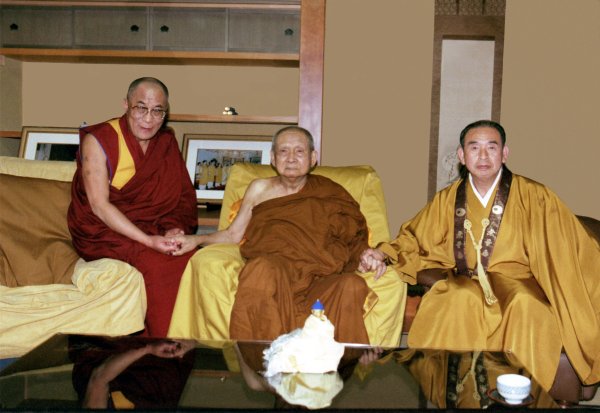Although it is probably correct to assume that the world is
innately varied, the world as we know it
is made of differences and distinctions. Among the many useful activities
performed by our very complex nervous system are the analysis and synthesis of
sensory data (including conceptions), the recognition of patterns, and the
comparison of those patterns with others stored in memory. Such processes,
together with others more obscure, enable us to make predictions about what
might occur in future, and to adjust both our expectations and our behavior
when things don’t go as we thought they would. Comparison is fundamental to our
ability to solve problems and adapt to novel opportunities. It is one of the
things we do best. It is also a habit and, therefore, a potential source of
difficulties.
When students of Zen read the Pali texts, we are bound to
notice that certain features of doctrine and practice differ from those
espoused by the Zen Ancestors and by our own teachers. The discrepancies will
strike us as odd because we are not just students of Zen but Zen Buddhists, after all. Enter the words “Zen”
and “Buddhism” into a search engine and you will bring up a list of items
numbering in the millions. What could be more natural than the linking of the
two terms? And yet, as we proceed with our studies, we may experience a growing
sense of tension between the two clusters of ideas. Uncovering the sources of
that cognitive dissonance is one of the great benefits of comparative studies.
Followers of the Theravada call themselves Buddhists, as do
Mahāyanists and devotees of Mantrayāna/Vajrayāna, despite marked differences in
doctrine and practice. Are they justified in doing so? I am old enough to
remember the early days of Buddhist ecumenism, when South Asian monastic elders
sat at long tables with their Mahāyāna counterparts, uttering the platitudes of
unity and cooperation, only to mock and denounce in private the heretical views
and apocryphal scriptures of their “co-religionists,” while Chinese abbots were
heard to impugn the decadence and moral turpitude of the tantric practitioners,
influenced no doubt by residual antipathy to the Ching (Mongol) Dynasty.
Attitudes have changed. There is nowadays not only a good deal more genuine
tolerance, but a growing willingness to learn from each other. As a result, it
is no longer necessary to devote quite so much energy to ignoring the obvious
differences between the three main Buddhistic traditions.
In the past those discrepancies have been managed, or
papered over, by means of theories that can be briefly summarized as follows:
·
The principal innovations in doctrine and practice became necessary on account
of a gradual deviation from the Dharma. They are the product of reform
movements aimed at restoring Buddhism to its original purity.
·
Novelties in theory and practice result from changing methods and standards of
interpretation, or what theologians call hermeneutical strategies. These in
turn depend upon speculations about what the Buddha really meant when he said,
“X,” or what the words of the text
imply.
·The
successive revisions of Buddhism are in fact improvements, in the manner of
free software upgrades. Thus, the Deer
Park discourse can be thought of as the Beta version
and the Three Turnings of the Wheel as Buddhism 1.0, 2.0, and 3.0.
·
A closely related rationale is that of Skillful Means (upāya), according to which the Buddha taught a great many diverse
things (sometimes simultaneously!), all of them appropriate to the needs and
capacities of his listeners. The computer-literate can think of these as
programs designed to run on the Śrāvaka, Pp/Madhamika, Yogacara and
Tathāgatagarbha platforms respectively.
·
Finally, there are tales according to which certain early texts (recall that the Buddha’s words were not
written down) were hidden for the purpose of being retrieved later, when a
more intelligent and spiritually evolved audience could fully appreciate their
deep meaning (recall that, according to
the doctrine of the decline of the Dharma, people’s faculties only deteriorated
from the Buddha’s time onward).
The common element in most attempts to reconcile the
inconsistencies in Buddhist teaching and practice is the assumption that the
Nikāyas, the Prajnāpāramita literature, the Extensive (vaipulya) Discourses, and the philosophical treatises are various
expressions of what is essentially
one thing. The limitations of such a view should be obvious. It is a bed of
Procrustes, requiring a constant labor of excision, whereas we should be
striving to be inclusive. “Original” and “pure” are words beloved of
fundamentalists and zealots. It is our obligation as scholars to examine the
details of each Buddhistic teaching for what it is on its own terms, and
evaluate each on its own merits, as a unique cultural artifact perfectly
expressive of its time, place and culture.
We are less likely to be broken between the Scylla of
ideology and the Charybdis of fact if we treat the main Buddhistic religions as
we do the Abrahamic, that is, as a group whose members share varying amounts of
genetic material, and therefore bear more or less of a family resemblance to
one another. In the case of Judaism and Christianity, the latter is
identifiable as a descendant of the former, but no one would mistake the one
for the other. The same kind of genetic relations hold for Early Buddhism, the Great Vehicle
so-called, and the Mahāyāna’s esoteric offspring, Mantrayāna and Zen.

No comments:
Post a Comment
Feel free to kibbitz or send me a personal message via this box. Comments will be moderated.